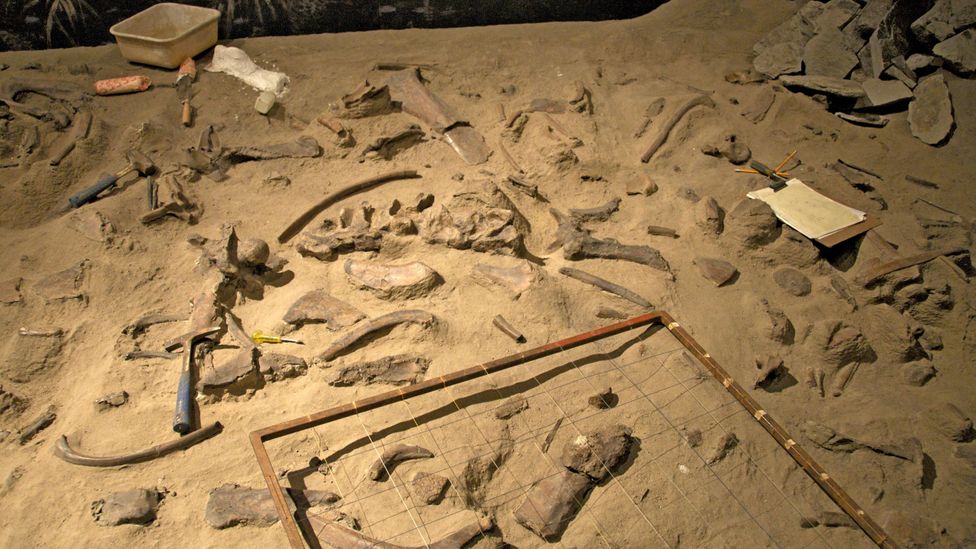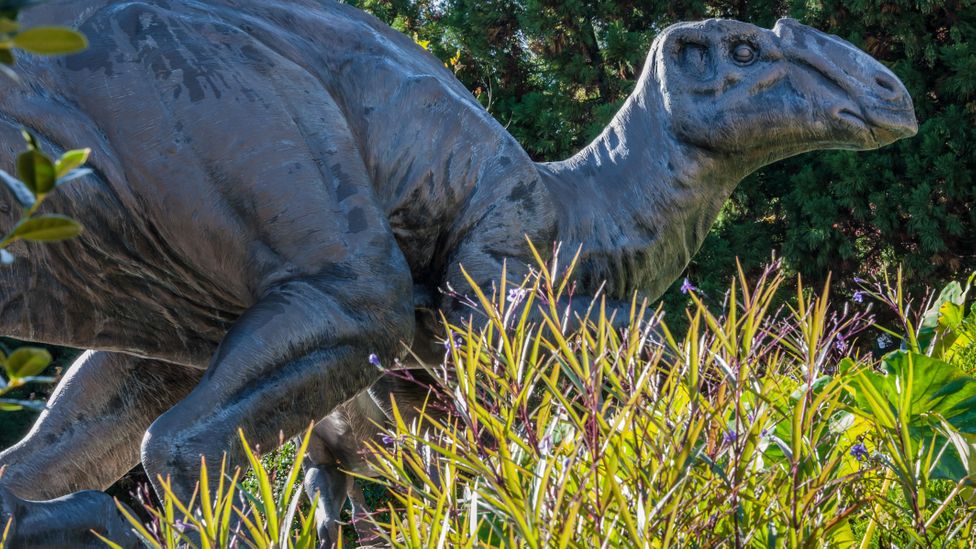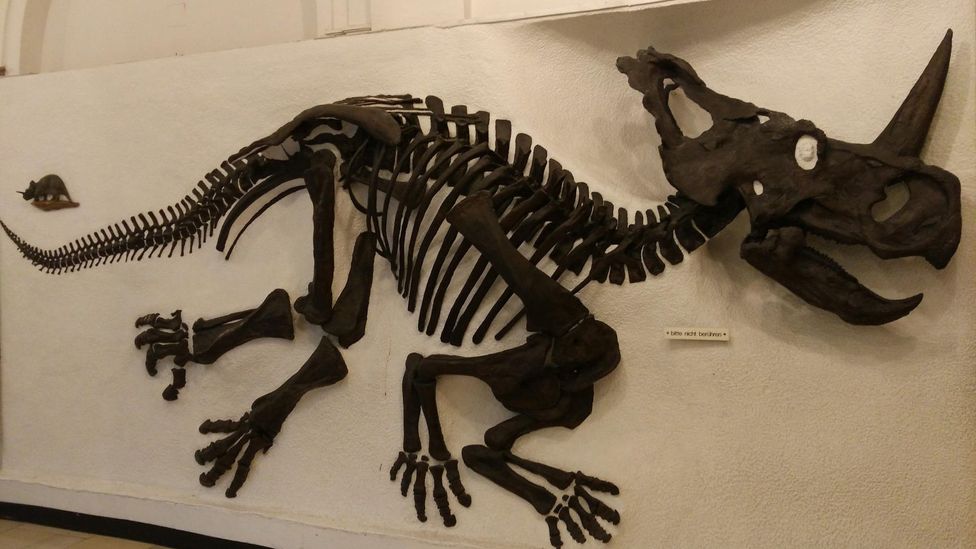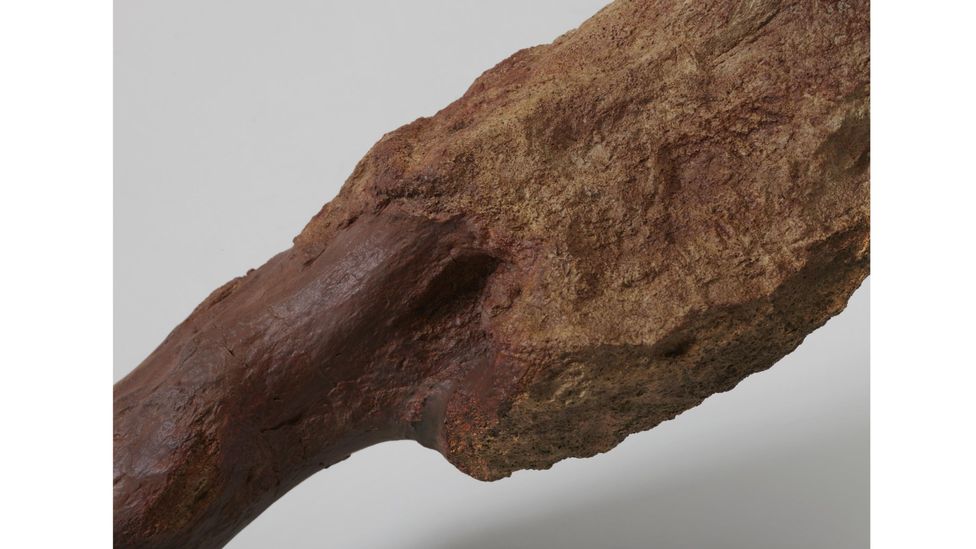Scientists have discovered the tell-tale signs of a range of dinosaur diseases – and found that they’re remarkably similar to those affecting animals alive today.
On a wet, stormy day some 77 million years ago in what is now south-eastern Alberta, Canada, a certain horned dinosaurwas having a very bad time.
The adult Centrosaurus apertus, a medium-sized plant-eating cousin of the larger Triceratops that lived alongside Tyrannosaurus, had an advanced malignant bone cancer in its shin. The cancer may have spread elsewhere in its body and it’s thought that it was almost certainly terminal.
But this Centrosaurus probably didn’t die from the bone cancer – because before this could happen, it and the thousands of other Centrosaurus in its herd were struck down in a catastrophic flood, thought to be caused by a tropical storm.
Millions of years later, the bonebed preserved after this mass death event helped provide important evidence that these dinosaurs moved in enormous herds. But the diagnosis of this particular dinosaur’s osteosarcoma – a rare, malignant bone cancer more commonly found in children and diagnosed in some 25,000 people per year worldwide – only came in 2020. It was the first time a malignant cancer had ever been diagnosed in a dinosaur, and it required a multidisciplinary team of scientists to confirm the case.
For decades, palaeontologists and palaeopathologists – scientists who study ancient diseases and injuries using fossils – have suggested findings of cancer in dinosaurs, although the tumours were usually thought to be benign. But the 2020 osteosarcoma study is part of a fast-growing field of research aimed at diagnosing dinosaur diseases, using similar expertise and equipment we would use to diagnose ailments in humans and animals today. The only difference is they have only fossils to go on.
“The field initiated as a speculation…but it actually is a scientific endeavour now, and we can scientifically test hypotheses, and develop criteria,” says Bruce Rothschild, a research associate in vertebrate palaeontology at the Carnegie Museum of Natural History, Pennsylvania. “It turns out the diseases that afflicted dinosaurs have essentially the same appearance as those that affect humans or other critters.”
The results of these investigations are revealing previously unknown details of how dinosaurs lived and died. Some argue they could also give medical experts new insights about the diseases still affecting us in the present day.
The vast assemblage of Centrosaurus skeletons at Dinosaur Provincial Park in Alberta, Canada, suggests they lived in herds (Credit: Alamy)
A rare find
The hunt to decisively diagnose a dinosaur with bone cancer started when David Evans, a palaeontologist at the University of Toronto and a curator at the Royal Ontario Museum in Canada, met Mark Crowther, a human haematologist and chair of the faculty of medicine at McMaster University, Canada. They realised they could use their combined expertise to try to find an osteosarcoma.
Still, finding a potential case was no easy task. Pathologies on fossil specimens are often noted, but they aren’t really curated – organised according to this characteristic – says Evans. Instead, bones with the hallmarks of disease are usually spread all over collections.
After sifting through hundreds of bones at Royal Tyrrell Museum in Drumheller, Canada, together with several other scientists including Snezana Popovich, a bone pathologist at McMaster University, they recognised the potential signs of bone cancer on the Centrosaurus apertus‘s shin bone. “I’ll definitely remember Snezana picking this bone up and being like, ‘I think this is bone cancer’,” says Evans.
The bone had a lump on the end of it that was labelled as a fracture callus, but even at first glance it had several tell-tale signs of bone cancer: it was visibly malformed and had large, unnatural foramina (open holes) around the lump.
The team, by now consisting of eight medical experts, including modern cancer specialists, and four palaeontologists, used every means they had to confirm a diagnosis in their 77-million-year-old patient. They compared the bone to both a normal Centrosaurus shin bone and a human calf bonewith a confirmed case of osteosarcoma. But they also used X-rays, high quality computed tomography (CT) scans along with 3D reconstruction tools and histology (thin sectioning of the bone) to create biopsies so they could study it at the cellular level.
“That allowed us to make a positive diagnosis of cancer that is on par with what the doctors on my team suggested [they would make] in a human patient,” says Evans. “We actually got right down to serial sectioning the bone… We were able to actually trace the cancerous tumour winding its way through the bone from the knee to the ankle.”
Scientists have found the first evidence of septic arthritis in the elbow of a hadrosaur unearthed in New Jersey (Credit: Alamy)
Penélope Cruzado-Caballero, a palaeontologist at the Universidad de La Laguna in Tenerife, Spain, says the study shows the importance of approaching pathologies in this multidisciplinary way, including the relatively new analysis of histology.
A wide search
It’s becoming increasingly common in palaeopathology to use modern techniques to make a medical diagnosis in this way, rather than simply visually comparing dinosaur ailments to other examples of diseases in a “card-matching game”, says Cary Woodruff, curator of vertebrate palaeontology at the Phillip and Patricia Frost Museum of Science in Miami, Florida. “Just because they look similar doesn’t mean [they are].”
Cruzado-Caballero recently documented another possible case of osteosarcoma. This time it was on the toe of a 70-million-year-old duck-billed herbivore, Bonapartesaurus rionegrensis, found in Patagonia, Argentina. Her team used imaging data and microscopic analysis, as well as descriptions of the visible shapes to diagnose a tumour.
“Our studies help us to understand when diseases arise throughout the history of life on Earth,” she says.
Osteosarcoma has been traced even further back than the Late Cretaceous period. Palaeontologist Yara Haridy and Rothschild diagnosed it in 240-million-year-old stem-turtle from the Triassic period using micro-CT scans, although they did not use as many different techniques as Evans’ team.
Scientists are also looking at dinosaur diseases in the context of other archosaurs, a group of reptilian animals that includes today’s crocodiles and birds. The approach helps palaeontologists understand how dinosaurs fit into the whole tree of life, says Jennifer Anné, lead palaeontologist at The Children’s Museum of Indianapolis.
In her work, Anné often collaborates with veterinary scientists to consider what kind of conditions are found in living birds and crocodilians to compare them with dinosaurs. “[It’s] almost being like a ‘palaeozoologist”, she says. “Like saying, ‘Alright, this is an animal, how do I study it as an animal?'”.
This was the approach which led Anné and two colleagues in 2016 to the first ever diagnosis in a dinosaur of septic arthritis – a condition that can occur when microbes get into a joint, often after an injury.
The hadrosaur from New Jersey had an “eaten away” elbow that “looked like a head of cauliflower”, says Anné, so they compared high resolution X-ray microtomography scans of the specimen to known conditions in living avians and reptiles. They ruled out several diseases, including gout and tuberculosis, before settling on the septic arthritis diagnosis due to the bone erosion, reactive bone growth and the fusion of the elements seen on the bones.
These new analyses can end up overturning previous diagnosis. In another example, research led by Ewan Wolff, a vet and palaeontologist at the University of Wisconsin, concluded that sets of smooth-edged lesions seen relatively frequently on the jaws of T. Rex were likely not bite wounds from other tyrannosaurids, as had previously been suggested, but an avian parasitic infection called trichomonosis, which causes similar effects in modern birds.
Sometimes, though, even the vets are stumped by these investigations. In a paper published last year, Anné and her colleagues outlined some unusual lesions they had found on another hadrosaur. But the veterinary scientists she talked to said they had never seen anything like it. “I sent this to the Royal Veterinary College in London and a picture of this is apparently hanging up in their coffee room, as people try to figure out what it is, because no one’s seen it on an extant animal either.”
Adult Centrosaurus were typically around 6m (19.7ft) long and weighed around 1,000kg (2,200lbs) (Credit: Alamy)
A new approach
The difference with diagnosing living animals today, of course, is that for dinosaurs there is very little to go on bar fossilised bone and other hard tissues like teeth, and sometimes skin, feathers or hair. “Anything where only one part of the diagnosis is bone, that’s really hard,” says Anné. “Because we have such limited information that we can use, those limited clues, we are the MacGyvers: we throw everything we can possibly do to try to tease out this information.”
Bone is usually one of the least studied parts of biology, she adds. “Whereas in palaeontology all we have is bones. So we know all about bones.”
Diagnosing any sort of malady in the fossil record is incredibly hard, agrees Woodruff. “We can’t rely really on any of the sweep of medical testing that we would do today… The way we go about identifying [diseases] has to be radically different.”
Woodruff, who specialises in sauropods – huge long-necked plant-eating dinosaurs like Brachiosaurus – also collaborated with veterinarians and medical doctors in his recent work to diagnose a dinosaur respiratory infection for the first time.
He had noticed something odd about a 150-million-year-old diplodocid sauropod specimen named Dolly – an irregular, lumpy growth on its vertebrae which had fossilised like a broccoli floret. “I knew enough to know what I was looking at was not normal, but I didn’t know enough to be able to identify what I even might be looking at,” he says.
He posted a picture to social media asking if anyone had seen something similar or knew what could it be, and quickly received a slew of responses, including from his future co-authors. “The general expert answer was, my gosh, we’ve never seen this before, but this is exactly what we would predict a respiratory infection in a sauropod to look like,” he says.
The team he assembled began investigating all the diseases which could have caused this growth. “It’s as important to weed out what it’s not sometimes certainly in the first passes than to help you zero in on what it is,” says Woodruff.
They realised there were protrusions in the exact areas of the bone which would have been attached to Dolly’s air sacs – air-filled structures which still occur in today’s birds, and which often become infected to cause the respiratory disorder airsacculitis. “They were similar enough that we were able to suggest that the diagnosis for Dolly was airsacculitis,” says Woodruff. “The fossil ‘broccoli’ coming out […] was a secondary bone infection.”
It’s impossible to say what could have caused this infection, as for obvious reasons the team couldn’t do any blood work on Dolly. However, the most common cause in living dinosaurs – birds – today is breathing in fungal spores. “Odds are, this could have been what occurred in our dinosaur 150 million years ago,” says Woodruff. “We know that fungus has a ridiculously long evolutionary history, it would have been a major component of these environments as well.”
Other scientists may have found signs of respiratory infections from even longer ago. A 2018 paper co-authored by Rothschild presented evidence of a tuberculosis-like respiratory infection in 245-million-year-old marine reptile.
Of course, palaeontologists have been studying diseases in dinosaur bones for decades, and some dinosaur ailments have far better records than others. Broken bones that have healed, for example, are “exceptionally common”, says Evans.
The Centrosaurus’ cancer would have been lethal, but the dinosaur was killed by a flood first (Credit: Royal Ontario Museum/ McMaster University)
Consider, though, that there is only skeletal material for around 32 adult T. rex out of an estimated 2.5 billion that ever lived, and the chances of understanding the prevalence of diseases becomes vanishingly small. “We really don’t have a good handle on the epidemiology,” says Rothschild. “All we can say is how far back, and we can trace a lot of these diseases back to the Permian, before the dinosaurs, but that’s as much as we can take it at the moment.”
There are also many ailments and diseases that leave no sign at all on what remains of dinosaurs, making it hard to know what killed them in most cases. “Probably a good chunk of our dinosaurs died from diseases or things like that, that we have no osteological evidence for, so no indicator on the bones,” says Woodruff.
Still, as science advances, we may get better at recognising clues that point to certain diseases. “There may be a whole bunch of bones that have diseases that are barely visible on the surface that no one would even think to look at,” says Evans.
The more these diagnoses are made, the more information palaeontologists can get about the way these dinosaurs lived.
For example, the Centrosaurus apertus‘s advanced osteosarcoma would likely have affected its movement, making it a prime target for a Tyrannosaurus, the top predator at the time, says Evans. Instead, though, it appears to have died with its herd in a natural disaster, which indicates it was maybe being cared for and protected by the rest of its herd, says Evans. “It’s a really interesting and unique insight into the life of dinosaurs that we didn’t have before.”
An unexpected benefit
But the discoveries could also contribute to our modern understanding of diseases. Rothschild, a practising medical rheumatologist, has used his analysis of hadrosaur fossils to help distinguish between osteochondritis and osteochondrosis, two different but similar-looking bone conditions.
Evans was even invited to participate in a symposium for the Osteosarcoma Institute, which focuses on finding a cure for the disease. “[There were] a bunch of top specialists in bone cancer from around the world [there], and then there was me with dinosaurs,” says Evans. His paper had diagnosed a giant tumour in the exact same place that you would expect to find the disease in a human. “It gives us some perspective to think about how ancient these diseases are.”
A cast of the original Centrosaurus apertus shin bone with osteosarcoma was also part of the Cancer Revolution exhibition last year at the Science Museum in London. “We wanted to showcase that cancer isn’t a uniquely human or modern disease,” says Katie Dabin, lead curator for the exhibition. “Dinosaurs seemed to be a brilliant example that cancer has been with multi-celled organisms for a long time.”
Evans hopes his paper will get medical doctors, researchers and experts interested in collaborating with palaeontologists and vice versa, prompting other findings about rare diseases that can be found in the fossil record. “Who knows where those discoveries might lead?” he says. His team is already working with another set of researchers who think they might have found evidence of osteosarcoma in a meat-eating dinosaur.
But there is also something about diagnosing these diseases in dinosaurs which simply helps us relate to them better, says Woodruff.
“You can hold that 150-million-year-old bone of Dolly [the diplodocus] in your hands, and, seeing those signs of infection caused by some sort of respiratory disorder, know that 150 million years ago, Dolly felt as crummy when it was sick as we all do when we’re sick with these similar things. And I think that’s fascinating.”
—
Join one million Future fans by liking us on Facebook, or follow us on Twitter or Instagram.
If you liked this story, sign up for the weekly bbc.com features newsletter, called “The Essential List” – a handpicked selection of stories from BBC Future, Culture, Worklife, Travel and Reel delivered to your inbox every Friday.






Hi, this is a comment.
To get started with moderating, editing, and deleting comments, please visit the Comments screen in the dashboard.